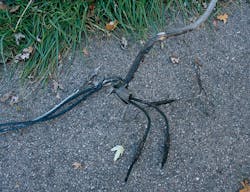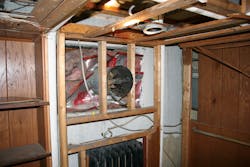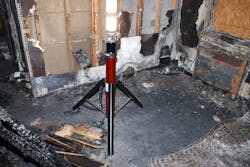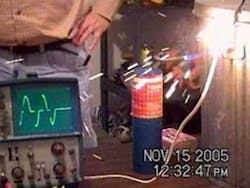The Case of the Service Cable Arcing Incident
When two distinctly separate fires occurred at the same time inside a house in southwestern Ohio, the homeowner was left searching for answers in the aftermath of destruction. Although thankfully no one was hurt in this case, the scenario could have had a much more tragic ending, should the fires have ignited during the night while the homeowner was sleeping, for example. The critical question at hand was to uncover the hidden culprit behind these two fires — and to determine how, if at all, they were related.
The scene
After noticing a little smoke coming from an exhaust fan in the basement on the west side of her house (the fan had not been running), the woman discovered the first fire. Remembering that her handyman lived nearby, she quickly called his cell phone. The handyman came within 5 min. Since the overhead lights were not working in the basement at the time, he plugged a lamp into a wall receptacle in the basement via an extension cord to see what was going on. He immediately noticed the carpeting below the exhaust fan was smoldering and that a cardboard box below the fan had ignited, so he used two glasses of water to extinguish the flames. Then he grabbed a knife to cut out the burned wood paneling around the exhaust fan to be sure the fire was out. Working live on the wiring, he disconnected the exhaust fan and put twist-on wire connectors on the ends of the “live” wires — a process that took at least 20 min.
As the handyman neared completion of this work, the homeowner, who had been watching him closely in the basement, went upstairs to the first level and was astonished to see flames as high as her head in the bedroom. “The whole bedroom is on fire!” she screamed down to him. At this point, the homeowner called for her dogs and quickly exited the house.
The handyman called the fire department and was put on hold three times before getting an answer. He walked outside to the front of the house and saw the window air conditioner to the bedroom engulfed in flames. He also noticed arcing in the service drop (the run of service cable between the electric utility transformer on the utility pole and the attachment point at the house) near its connection to the service entrance (the run of service cable between the attachment point on the house and the main circuit breaker or fuse panel inside the house). The homeowner characterized this arcing as “a lot of little fireworks, like sparklers” that sounded like “glasses popping.” Suddenly, the service drop conductors fell away from the house and continued to spark on the ground (Photo 1). They were still arcing when the fire department arrived.
The investigation
The homeowner was certain there was no fire around the service drop when she first saw it arcing. She stated that no one in the house smoked, and there were no candles in use at the time of the fire. She also recalled that the service drop had been replaced by the electric utility three months earlier after a semi-truck struck and knocked it down. However, the homeowner was not sure whether the electric utility had replaced the entire service drop or merely re-attached the disconnected conductors to the house.
Examination of the wiring to the exhaust fan and in the bedroom revealed copper melts indicative of short circuit arcing (Photo 2), yet there was no path of fire communication between these two widely separate areas of burn damage (Photo 3). This indicated there had to be a common cause of the two areas of branch circuit arcing.
Forensic analysis
When arcing occurs in AC circuits, the arc is extinguished every time the current goes through the zero point of the sine wave. Extensive testing with a storage oscilloscope (a device used to save each sweep of the current waveform until you erase the data) has shown the arc often does not re-ignite in 15A and 20A branch circuits until the voltage in the sine wave rises to a level well above zero — a high level would be considered half way to the peak of the sine wave. At that time, upon arc re-ignition, the electrical current jumps suddenly to its normal level in the sine wave. These jumps and resultant missing portions of the sine wave can be seen in Photo 4, where an AFCI has detected them and used the missing portions of waveform to decide to trip.
It was theorized, with some confidence, that arcing in the service cable would behave in the same manner, producing jumps in the current waveform. These jumps (step-functions) would produce very high transient voltages in the electric utility transformer, because of the transformer’s inductance. Those very high voltages would then be transferred to the wiring in the house. The household wiring is only rated for 600V. It was opined that the transient voltages from jumps in the service drop arcing current waveform rose well above this 600V level to punch through the branch circuit wirings insulation and create two separate arcing fires.
The intermittent arcing in the service cable that caused this fire was observed to continue unabated because the impedance of the utility transformer and the service drop, along with the resistance of the arc, combined to keep the primary current below what it takes to open the primary fuse. Three or four separate fires had been observed inside a residence in other such cases. It was my opinion that if electric utility transformers had secondary fuses, most service cable fires, which are 1% of total fires, would be prevented.
Lessons learned
It is now well known that common 15A and 20A circuit breakers, as opposed to AFCIs, often do not prevent short circuit arcs from causing a fire in branch circuits. When electrical insulation breaks down, the resistance of the short circuit arc, combined with the resistance of the household wiring, can keep the arcing current below the magnetic trip level of the circuit breaker. Furthermore, most of the intermittent arcs do not last long enough to initiate the thermal trip. Between the arcs, the thermal trip has time to cool down. You can view a video demonstration of this phenomenon at www.paceforensic.com, where a power cord arcs more than 30 times for 2 min. before it trips a 20A branch circuit breaker.
In summary, the latent defect in the service drop, which occurred when it was damaged by the semi-truck, produced high transient voltages that entered the house and created arcing in two widely separate branch circuit locations. The primary fuse at the utility transformer and the circuit breakers in the house were unable to react quickly enough, if at all, to prevent these two fires.
The settlement
Because the service cable in this case had been recently replaced or repaired by the electric utility, the homeowner’s insurance company filed a claim for damages against the utility. The expert for the utility suggested that generalized surges other than from the arcing in the service cable entered this house to cause the fires. Nevertheless, the case settled out of court in favor of the client’s insurance company for an undisclosed amount.
Franklin has been an electrical/mechanical forensic engineer for 40 years. He currently serves as president of Professional Analytical and Consulting Engineers, Cincinnati. He can be reached at [email protected].




